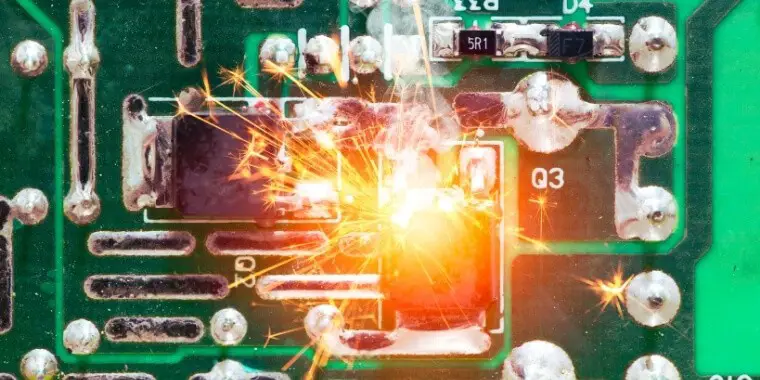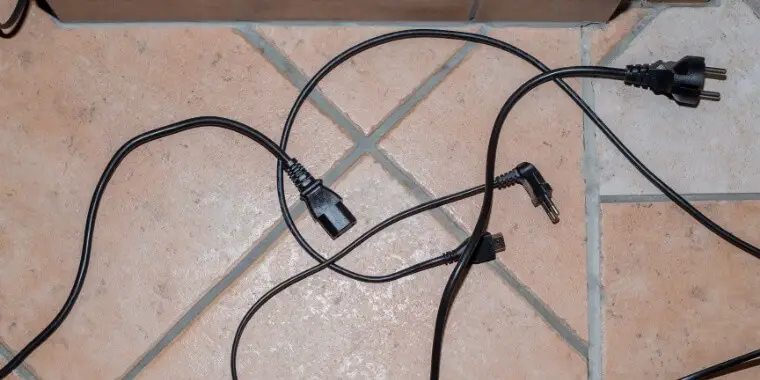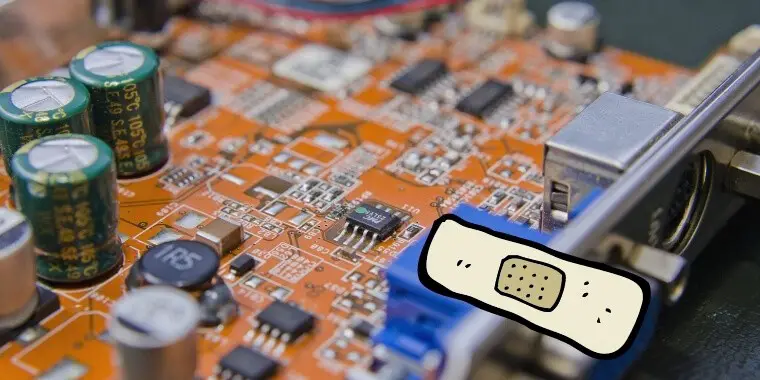You’ve just had a healthy breakfast and turned on your computer to start your day. You begin working, but a few minutes later, the monitor suddenly turns off and on. At first, this might not bother you, so you continue working.
However, if this ON and OFF behavior keeps happening repeatedly, you seriously start thinking that something is wrong. You start thinking about why my monitor turns OFF and ON every few seconds.
If you’re experiencing this issue, you’re not alone. Many computer users face this problem, and it often indicates a need for troubleshooting to identify and fix the cause.
In this post, I’ll explore the potential causes of monitors repeatedly turning on and off, as well as possible solutions to this issue.
Causes of Monitor Turning OFF and ON Repeatedly
A couple of issues can cause your monitor to turn OFF and ON. While some of them are associated with the monitor, a few relate to the computer system. The following are these causes:
Cause 1: Monitor Overheating

When a monitor is overheating, it automatically goes OFF to keep circuitry damage at bay. The reasons for overheating are excessive heat, dust accumulation, or vent blockage.
If the monitor is old, too much dust accumulation jams the monitor vents due to which the heat cannot escape. This can result in turn OFF to keep the risk of disrupting the circuitry.
Another cause in the case of an old monitor is the set of aging capacitors within the monitor circuits that are unable to retain the charge for sufficient time for supplying it to the other parts.
Solution:
If overheating is the cause, disconnect the monitor and allow it to cool completely prior to connecting it again for use. Before you put it back to use, do clean the vents using a vacuum cleaner gently. Alternatively, you can use anti-static canned air to blow away the dust inside the casing of the monitor.
If the room in which the computer is present is hot, cool it down via an AC or a fan. Allow the room to cool prior to using the monitor again. If aging capacitors are the cause, consider reducing the brightness of your monitor.
Doing so consumes less power due to which you can then use the monitor. In the case of a very old CRT model, consider replacing it with a flat-panel display to fix several heat-based issues at once.
Cause 2: Loose Cables

At times, carelessness or a silly thing can be the cause of this monitor issue. In the case of the monitor turning OFF and ON, this can be a loose display cable. So, just examine the cable that connects the monitor to the system and see whether it is loose or not.
The same problem can be with the power cable or cord that connects the monitor with the socket. If it is not well connected to the monitor’s back, it results in power loss due to which the monitor tends to turn OFF.
At times, the monitor cables could be damaged via twists and pinches whose symptoms are visible at the ends. This can short-circuit the signal and make the screen go black.
Solution:
As a wise user, the first thing to do is to unplug both the monitor display cable and the monitor power cord and re-plug them securely and tightly. For this, just see both the ends of each cable at the rear of the monitor.
The power cord runs from the electrical outlet to the monitor. Once found, remove it and reconnect it. The display cable responsible for rendering the visuals from the PC to the screen runs from the rear of the monitor to the rear of the CPU. This will be a big, black one in the form of a 15-pin VGA, DVI, or HDMI cord. Ensure that you screw the ends well.
An HDMI cable cannot be screwed but you should tightly fix it. In case of small space or too thick cord such that it cannot bend well for connection, consider investing in an HDMI adapter. Now, watch the monitor to see if the issue is resolved.
If not, it is time to check DVI and HDMI setup. If you are using these cables, you need to take care of some additional considerations. Both of them are digital signals. So, if any of them is weak or has been split using a splitter, the monitor is likely to go blank due to loss of signal strength. This can happen even if the cord is too long.
At times, an HDMI cable tends to stop functioning well due to a recent hardware setting. For instance, you may have used the cable for an external device such as a splitter instead of plugging it directly into the monitor. If this is the cause, you can test just by removing that external device.
At last, try checking with another spare HDMI cable. If this does not fix the issue, consider buying a new but thicker HDMI cable to get a strong signal.
In case of a damaged cable, unplug it and physically check it for bent pins, tears, twist marks, and pinch marks. To uproot this cause, you will have to replace the cable. If there are bent pins, you can first try straightening them with a screwdriver after disconnecting the cable.
Don’t miss: How To Fix Green Computer Screen?
Cause 3: Defective or Malfunctioning Graphic Card

Another common cause of the monitor turning OFF and ON frequently is faulty GPU. You can easily check if this is the cause in your case.
To do so, just remove the graphics or video card and watch the system for the monitor’s issue. If resolved, it means that the GPU was at the fault. In some cases after monitor turning on you might face Generic PnP Monitor Error that’s also caused by GPU.
This cause is common in case of an external GPU card, which could be dead or faulty. Here, for verification, consider using the graphics port integrated into your motherboard. These days, most CPUs or motherboards come with built-in graphics. If it worked, it means that the external GPU card is faulty or its driver is obsolete or not updated.
Solution
You first should update all the graphic card drivers. You can download and install the latest drivers from the official website of its manufacturer. To know the manufacturer and update these drivers without going to the official website, perform the following steps:
- In the search box of the Start menu or on the Taskbar, enter device manager.
- Select Device Manager. The Device Manager window is displayed.
- Locate and expand the Display adapter node.
- Look for an entry that says Intel, graphics, AMD, ATI, VGA, or NVIDIA. These are the popular brand or manufacturer names.
- Double-click the entry of your graphics or video card. The Properties dialog box is displayed.
- Select the Driver tab.
- Click Update Driver.
If the issue is still there, consider cleaning the card and put it again on the motherboard. If doing also does not resolve the issue, the only solution then is to replace the graphic card with a new one.
Cause 4: Other hardware problems
Hardware problems can also contribute to monitors repeatedly turning on and off. Here are two common hardware issues that can cause this problem:
- Internal component failure: Issues with internal monitor components, such as capacitors, can cause the monitor to turn on and off repeatedly. This can occur due to age, wear, and tear, or other issues that impact the normal functioning of the monitor.
- Motherboard or BIOS issues: Faulty motherboards or BIOS settings can interfere with the normal operation of the monitor, causing it to turn on and off. This can occur due to issues with the motherboard’s power supply or other critical components.
Solution
To address hardware issues, users can start by checking for loose connections or damaged components within the monitor or computer.
If the problem persists, you may need to consult a professional technician to diagnose and repair the underlying issue. In some cases, this may require replacing damaged components or upgrading the graphics card or motherboard.
Cause 5: Malfunctioning Power Supply Unit (PSU)
If the connection between your PSU and the monitor is loose, it can cause the monitor to turn off and on repeatedly, particularly while playing games.
This issue is more likely to occur when a high-powered GPU puts a strain on the PSU. Sometimes, dust build-up on the PSU and its fans can also cause this issue.
To determine if this is the cause of the problem, you can open your CPU and check the connection to the PSU.
A faulty power supply can contribute to this issue in three ways:
Inconsistent power delivery: A faulty power supply can deliver inconsistent power to the monitor, causing it to turn off and on repeatedly. This issue can result from damaged or worn-out components within the power supply or problems with the power outlet or circuit.
Voltage fluctuations: Voltage fluctuations or electrical noise can disrupt the monitor’s normal functioning, causing it to turn off and on unexpectedly. These fluctuations can occur due to a range of factors, including power surges, lightning strikes, and faulty wiring.
Failing components: Over time, components within the power supply can age or become damaged, leading to instability and issues with the monitor. This includes critical components like capacitors, transformers, and other components that regulate power delivery to the monitor.
Solution:
To address this issue, you can start by cleaning the PSU and its fans.
If the issue persists, you can have a professional technician test the PSU with another powerful one, as this is not recommended for users to do it themselves.
If the new PSU resolves the issue, it means the problem is with the existing PSU, and you will need to buy a new one.
The solution to the issues mentioned above would depend on the specific cause of the problem, but here are some possible solutions for each of the three causes:
Inconsistent power delivery: If the power supply is faulty, it may need to be replaced or repaired. Users can consult a professional technician to diagnose the issue and recommend a solution. Alternatively, you can try plugging the monitor into a different power outlet or circuit to see if the problem persists.
Voltage fluctuations: To address voltage fluctuations, users can try using a surge protector or uninterruptible power supply (UPS) to regulate the power supply to the monitor. If electrical noise is the problem, you can try moving the monitor away from other electronic devices or sources of interference.
Failing components: If components within the power supply are aging or damaged, they may need to be replaced. You can consult a professional technician to diagnose the issue and replace the damaged components. In some cases, it may be more cost-effective to replace the entire power supply rather than individual components.
Cause 6: Monitor Turns Off and On Repeatedly Because Of Screen Saver or Activated Energy Saving Mode

If you have enabled the screen saver or are using the Energy Saving mode, it can force the monitor to go OFF and ON. It can even power it OFF completely.
Solution:
To negate this cause, perform the following steps to reset the power options and stop the screen saver:
- Hold the Windows logo key and press the R key to open the Run dialog box.
- Enter powercfg.cpl. The Power Options widget is displayed.
- Ensure Balanced or High Performance is selected and corresponding to it, click Change plan settings. The Edit plan settings window is displayed.
- Set Turn off the display to Never.
- Click Apply.
- Open the Run dialog box again and enter desk.cpl,,@screensaver. The Screen Saver Settings window is displayed.
- Set the Screen saver drop-down field to None.
- Click Apply.
Now, see if the problem is resolved.
If these fixes do not work for you, it is time to repair or replace the monitor.
You may be also interested in:
Why You Shouldn’t Ignore the Issue?
Addressing the issue of a monitor that repeatedly turns on and off is crucial not only for productivity but also for the longevity of the device.
In professional settings, this issue can severely impact productivity by preventing users from completing tasks efficiently, leading to missed deadlines, wasted time, and even potential loss of revenue.
Ignoring the issue can worsen underlying problems, leading to permanent damage to the monitor or other components in the computer system. Addressing the issue promptly can help prevent further damage and extend the lifespan of the device.
Moreover, resolving the issue early on can save you from costly repairs or replacements later down the line, which can add up significantly over time.
In summary, it is important to address the issue of a monitor that repeatedly turns on and off not only to improve productivity but also to prevent damage to the device and save costs in the long run.
Tips For Preventing Future Issues
Maintain Proper Ventilation and Cleanliness
Make sure your monitor has enough space around it for proper airflow. Avoid placing objects too close to the vents, and keep the monitor away from direct sunlight or other heat sources.
Dust and debris can accumulate over time, clogging air vents and reducing the efficiency of your monitor’s cooling system. Regularly clean the vents using a soft brush or compressed air to prevent dust buildup.
Keep the room temperature and humidity at optimal levels to prevent overheating and condensation that could damage the monitor’s internal components.
Regularly Update Software and Drivers
Stay on top of software updates for your operating system and graphics drivers. These updates often include performance improvements and bug fixes that can help prevent monitor-related issues.
Enable automatic updates for your operating system and graphics drivers to ensure you always have the latest, most stable versions installed.
Some applications can interfere with display settings or drivers. Only install trusted software and promptly remove any programs that cause issues with your monitor.
Use High-Quality Cables and Power Supplies
Opt for high-quality cables and power supplies that meet or exceed the specifications recommended by your monitor’s manufacturer. Better quality components can provide more stable power delivery and data transmission.
Ensure that the cables you use are compatible with your monitor and other hardware components. Incompatible cables can cause display issues and even damage your devices.
Periodically check your cables for signs of wear and tear, such as fraying or kinking. Replace damaged cables promptly to avoid potential problems.
Monitor System Performance and Temperatures
Utilize software tools that monitor your system’s performance, including temperature readings for your monitor, graphics card, and other components. Keeping an eye on these metrics can help you identify potential issues before they become serious problems.
If you notice unusually high temperatures or other signs of stress on your monitor or related components, adjust your display settings or system configuration to reduce the load.
Regularly inspect and maintain your computer system, including the monitor, to ensure all components are functioning optimally. This can help prevent future issues and extend the lifespan of your devices.
Conclusion
It is easy to fix the issue of the monitor turning OFF and ON repeatedly by trying one or more solutions mentioned above.
Also, remember that when taking a proactive approach to monitoring maintenance can save you time, frustration, and money in the long run.
Your monitor is an essential part of your daily life—treat it well, and it will serve you well in return.